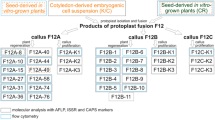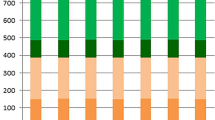Abstract
Asymmetric somatic hybrids were obtained between Gossypium hirsutum Coker 201 and wild cotton G. klozschianum Anderss. An investigation on the effect of ultraviolet (UV) irradiation on donor protoplasts was carried out, and the lethal dose was determined to be 38.7 J cm−2. We firstly screened the putative hybrids by the color of the calli produced, followed by morphological, cytological, and molecular analysis of putative hybrid plants. Most regenerated plants derived from fused protoplasts displayed a recipient-like morphology, while some showed an intermediate phenotype between Coker 201 and G. klozschianum. Chromosome numbers in these somatic hybrids ranged from 54 to 74. The hybrids were verified by random amplified polymorphic DNA (RAPD) and simple sequence repeat (SSR). Absence or co-existence of parents’ genome DNA fragments was identified through molecular analysis. The heredity of cytoplasm was investigated by cleaved amplified polymorphic sequence (CAPS) analysis using mitochondrial and chloroplast universal primer pairs. The results indicated that recombination and rearrangements might have occurred in some regions of mitochondria (mt) and chloroplast (cp) DNA. To our knowledge, this is the first report about asymmetric protoplast fusion in cotton, and the hybrids obtained would be useful for breeding programs.







Similar content being viewed by others
Abbreviations
- CAPS:
-
Cleaved amplified polymorphic sequence
- cpDNA:
-
Chloroplast DNA
- CPW:
-
Cell and protoplast washing solution (Frearson et al. 1973)
- CTAB:
-
Cetyltrimethyl ammoniumbromide
- FDA:
-
Fluorescein diacetate
- GFP:
-
Green fluorescent protein
- IBA:
-
Indole-3-butyric acid
- IOA:
-
Iodoacetamide
- MES:
-
2, (N-morpholino) ethane sulfonic acid
- MSB:
-
MS medium (Murashige and Skoog 1962) and B5 (Gamborg et al. 1968) vitamins
- mtDNA:
-
Mitochondrial DNA
- PAGE:
-
Polyacrylamide gel electrophoresis
- RAPD:
-
Random amplified polymorphic DNA
- SSR:
-
Simple sequence repeat
- UV:
-
Ultraviolet
References
Binsfeld PC, Wingender R, Schnabl H (2000) Characterization and molecular analysis of transgenic plants obtained by microprotoplast fusion in sunflower. Theor Appl Genet 101:1250–1258
Binsfeld PC, Schnabl H (2002) Molecular and cytogenetic constitution of plants obtained via two different somatic hybridization methods. Plant Cell Rep 21:58–62
Cabasson CM, Luro F, Ollitrault P, Grosser W (2001) Non-random inheritance of mitochondrial genomes in Citrus hybrids produced by protoplast fusion. Plant Cell Rep 20:604–609
Chen JF, Luo XD, Qian CT, Jahn MM, Staub JE, Zhuang FY, Lou QF, Ren G (2004) Cucumis monosomic alien addition lines: morphological, cytological and genotypic analyses. Theor Appl Genet 108:1343–1348
Cheng YJ, Guo WW, Deng XX (2003) Molecular characterization of cytoplasmic and nuclear genomes in phenotypically abnormal Valencia orange (Citrus sinensis) + Meiwa kumquat (Fortunella crassifolia) intergeneric somatic hybrids. Plant Cell Rep 21:445–451
Derks FHM, Hakkert JC, Verbeek WHJ, colijn-Hooymans CM (1992) Genome composition of asymmetric hybrids in relation to the phylogenetic distance between the parents: nucleus-chloroplast interaction. Theor Appl Genet 84:930–940
Dudits D, Maroy E, Praznovszky T, Olah Z, Gyorgyey J, Cella R (1987) Transfer of resistance traits from carrot into tobacco by asymmetric somatic hybridization: regeneration of fertile plants. Proc Natl Acad Sci USA 84:8434–8438
Famelaer I, Gleba YY, Sidorov VA, Kaleda VA, Parokonny AS, Boryshuk NV, Cherep NN, Negrutiu I, Jacobs M (1989) Intrageneric asymmetric hybrids between Nicotiana plumbaginifolia and Nicotiana sylvestris obtained by “gamma-fusion”. Plant Sci 61:105–117
Frearson EM, Power JB, Cocking EC (1973) The isolation, culture and regeneration of petunia leaf protoplasts. Dev Biol 33:130–137
Gamborg OL, Miller RA, Ojima K (1968) Nutrient requirements of suspension culture of soybean roots cells. Exp Cell Res 50:150–158
Hall RD, Rouwendal GJA, Krens FA (1992a) Asymmetric somatic cell hybridization in plants. I. The early effects of (sub) lethal doses of UV and gamma radiation on the cell physiology and DNA integrity of cultured sugarbeet (Beta vulgaris L.) protoplasts. Mol Gen Genet 234:306–314
Hall RD, Rouwendal GJA, Krens FA (1992b) Asymmetric somatic cell hybridization in plants. II. Electrophoretic analysis of radiation-induced DNA damage and repair following exposure of sugarbeet (Beta vulgaris L.) protoplasts to UV and gamma rays. Mol Gen Genet 234:315–324
He DH, Lin ZX, Zhang XL, Nie YC, Guo XP, Zhang YX (2007) QTL mapping for economic traits based on a dense genetic map of cotton with PCR-based markers using the interspecific cross of Gossypium hirsutum × G. barbadense. Euphytica 153:181–197
Jin SX, Zhang XL, Liang SG, Nie YC, Guo XP, Huang C (2005) Factors affecting transformation efficiency of embryogenic callus of upland cotton (Gossypium hirsutum) with Agrobacterium tumefaciens. Plant Cell Tissue Organ Cult 81:229–237
Kao KN, Michayluk MR (1975) Nutrient requirements for growth of Vicia hajastana cells and protoplasts at a very low population density in liquid media. Planta 126:105–110
Kanno A, Kanzaki H, Kameya T (1997) Detailed analyses of chloroplast and mitochondrial DNAs from the hybrid plant generated by asymmetric protoplast fusion between radish and cabbage. Plant Cell Rep 16:479–484
Kovtun YV, Korostash MA, Butsko YV, Gleba YY (1993) Amplification of repetitive DNA from Nicotiana plumbaginifolia in asymmetric hybrids between Nicotiana sylvestris and Nicotiana plumbaginifolia. Theor Appl Genet 86:221–228
Kumria R, Sunnichan VG, Das DK, Gupta SK, Reddy VS, Bhatnagar RK, Leelavathi S (2003) High-frequency somatic embryo production and maturation into normal plants in cotton (Gossypium hirsutum) through metabolic stress. Plant Cell Rep 21:635–639
Liang ZL (1999) Genetics and breeding of distant hybridization in cotton, 2nd edn. Science press, Beijing, pp 1–5
Masako T, Yousuke T, Kuniya A, Norio N, Takashi T (2001) Supplementary material nuclear reprogramming of somatic cells by in vitro hybridization with ES cells. Curr Biol 2:1553–1558
McCabe PF, Dunbar LJ, Guri A, Sink KC (1993) T-DNA-tagged chromosome 12 in donor Lycopersicon esculentum x L. Pennellii is retained in asymmetric somatic hybrids with recipient Solanum lycopersicoides. Theor Appl Genet 86:377–382
Melzer JM, O’Connell MA (1992) Effect of radiation dose on the production of, and the extent of, asymmetry in tomato asymmetric somatic hybrids. Theor Appl Genet 83:337–344
Menczel L, Galiba G, Nagy F, Maliga P (1982) Effect of radiation dosage on efficiency of chloroplast transfer by protoplast fusion in Nicotiana. Genchc 100:457–495
Murashige T, Skoog F (1962) A revised medium for rapid grouth and bio assay with tobacco tissue cultures. Physiol Plant 15:473–479
Negrutiu I, Hinnisdaels S, Mouras A, Gill BS, Gharti-Chhetri GC, Davey MR, Gleba YY, Sidorov V, Jacobs M (1989) Somatic versus sexual hybridization: features, facts and future. Acta Bot Neerl 38:253–272
Oberwalder B, Schilde-Rentschler L, Ruoû B, Wittemann S, Ninnemann H (1998) Asymmetric protoplast fusions between wild species and breeding lines of potato—effect of recipients and genome stability. Theor Appl Genet 97:1347–1354
Paterson AH, Brubaker CL, Wendel JF (1993) A rapid method for extraction of cotton (Gossypium spp.) genomic DNA suitable for RFLP and PCR analysis. Plant Mol Biol Rep 11:112–127
Ramulu KS, Dijkhuis P, Famelaer I, Cardi T, Verhoeven HA (1993) Isolation of sub-diploid microprotoplasts for partial genome transfer in plants—enhancement of micronucleation and enrichment of microprotoplasts with one or a few chromosomes. Planta 190:190–198
Ramulu KS, Dijkhuis P, Rutgers E, Blass J, Krens FA, Verbeek WHJ, Colijn-Hooymans CM, Verhoeven HA (1996) Intergeneric transfer of a partial genome and direct production of monosomic addition plants by microprotoplast fusion. Theor Appl Genet 92:316–325
Sun YQ, Zhang XL, Nie YC, Guo XP, Jin SX, Liang SG (2004) Production and characterization of somatic hybrids between upland cotton (Gossypium hirsutum) and wild cotton (G. klotzschianum Anderss) via electrofusion. Theor Appl Genet 109:472–479
Sun YQ, Zhang XL, Nie YC, Guo XP (2005) Production of fertile somatic hybrids of Gossypium hirsutum + G. bickii and G. hirsutum + G. stockii via protoplast fusion. Plant Cell Tissue Organ Cult 83:303–310
Sun YQ, Nie YC, Guo XP, Huang C, Zhang XL (2006) Somatic hybrids between Gossypium hirsutum L. (4×) and G. davidsonii Kellog (2×) produced by protoplast fusion. Euphytica 151:393–400
Vlahova M, Hinnisdaels S, Frulleux F, Claeys M, Atanassov A, Jacobs M (1997) UV irradiation as a tool for obtaining asymmetric somatic hybrids between Nicotiana plumbaginifolia and Lycopersicon esculentum. Theor Appl Genet 94:184–191
Wardrop J, Fuller J, Powell W, Machray GC (2004) Exploiting plant somatic radiation hybrids for physical mapping of expressed sequence tags. Theor Appl Genet 108:343–348
Wolters AMA, Schoenmakers HCH, van der Meulen-Muisers JJM, van der Knaap E, Derks FHM, Koorneef M, Zelcer A (1991) Limited DNA elimination from the irradiated potato parent in fusion products of albino Lycopersicon esculentum and Solanum tuberosum. Theor Appl Genet 83:225–232
Wu JH, Zhang XL, Nie YC, Jin SX, Liang SG (2004) Factors affecting somatic embryogenesis and plant regeneration from a range of recalcitrant genotypes of Chinese Cottons (Gossypium hirsutum L.). In Vitro Cell Dev Biol Plant 40:371–375
Xia GM, Chen HM (1996) Plant regeneration from intergeneric somatic hybridization between Triticum aestivum L and Leymus chinesis (Trin) Tzvel. Plant Sci 120:197–203
Xia GM, Xiang FN, Zhou AF, Wang H, Chen HM (2003) Asymmetric somatic hybridization between wheat (Triticum aestivum L.) and Agropyron elongatum (Host) Neviski. Theor Appl Genet 107:299–305
Zhang TZ, Yuan YL, Yu J, Guo WZ, Kohel RJ (2003) Molecular tagging of a major QTL for fiber strength in Upland cotton and its marker-assisted selection. Theor Appl Genet 106:262–268
Zheng XY, Wolff DW, Baudracco-Arnas S, Pitrat M (1999) Development and utility of cleaved amplified polymorphic sequences (CAPS) and restriction fragment length polymorphisms (RFLPs) linked to the Fom-2 fusarium wilt resistance gene in melon (Cucumis melo L.). Theor Appl Genet 99:453–463
Zhou CE, Xia GM, Zhi DY, Chen Y (2005) Genetic characterization of asymmetric somatic hybrids between Bupleurum scorzonerifolium Willd and Triticum aestivum L.: potential application to the study of the wheat genome. Planta 223:714–724
Acknowledgments
The author X. Y. Yang thanks Y. X. Zhang and L. L. Tu for technical assistance with the molecular analysis. This research was supported by program for New Century Excellent Talents in University (NCET-04-0739) and National Basic Research program of China (2004CB117301).
Author information
Authors and Affiliations
Corresponding author
Rights and permissions
About this article
Cite this article
Yang, Xy., Zhang, Xl., Jin, Sx. et al. Production and characterization of asymmetric hybrids between upland cotton Coker 201 (Gossypium hirsutum) and wild cotton (G. klozschianum Anderss). Plant Cell Tiss Organ Cult 89, 225–235 (2007). https://doi.org/10.1007/s11240-007-9245-0
Received:
Accepted:
Published:
Issue Date:
DOI: https://doi.org/10.1007/s11240-007-9245-0




